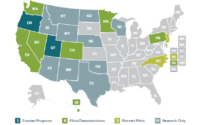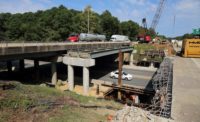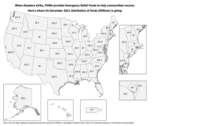The Federal Highway Administration has issued a final regulation requiring state departments of transportation to chart tailpipe emissions of greenhouse gases, with the goal of reducing those levels.
The regulation, announced on Nov. 22, drew praise from a key House Democrat but was slammed by a senior GOP Senator, who says FHWA overreached its authority by issuing the rule. One senior transportation official expects that critics will challenge the new rule in court.
FHWA Administrator Shailen Bhatt said transportation is the largest source of carbon dioxide emissions in the U.S. and that “reducing emissions from that sector while ensuring the economy works for everyday Americans is critical to addressing the climate crisis."
The regulation goes into effect 30 days after it is published in the Federal Register.
The rule does not set a nationwide emissions reduction level. According to the text of the regulation, "The rule does not mandate how low targets must be." Rather, it says, "State DOTs and [metropolitan planning bodies] have flexibility to set targets that are appropriate for their communities and that work for their respective climate change and other policy priorities, as long as the targets aim to reduce emissions over time."
But they all must report their target emissions levels to FHWA by Feb. 1, 2024.
Under the rule, the benchmark measurement is the percent change in on-road tailpipe carbon dioxide emissions on the Interstate network and other major arterials compared with 2022 levels. States are required to set levels for two years and four years after the base year of 2022.
For States, a Difficult Deadline
That deadline is tight, says Jim Tymon, the American Association of State Highway and Transportation Officials' executive director.
Tymon says that the emissions data will not be available until Nov. 30 and thus the Feb. 1 date "is going to mean that states are going to have to scramble pretty quickly to establish these targets."
He adds, "That's the number-one impact that you're going to see in the short term."
Tymon says that about 10 to 15 states already have their greenhouse gas tracking systems in place or are in the process of doing so.
But other states have not done so and are saying the Biden administration lacks the authority to require them to establish the GHG mechanisms.
Split Opinions in Congress
On Capitol Hill, views about the new regulation were split. Rep. Rick Larsen (Wash.), the top Democrat on the House Transportation and Infrastructure Committee, praised the rule. He said, “Measuring and reporting the amount of greenhouse gases coming from vehicles on our roads is a key step in achieving a more sustainable transportation future.”
But Sen. Shelley Capito, the lead Republican on the Environment and Public Works Committee, criticized the regulation, contending that FHWA overstepped its authority.
Capito said, “Federal overreach to advance a misguided climate agenda has become a staple of the Biden administration." She added that during 2020 negotiations over what became the Infrastructure Investment and Jobs Act, language giving authority for FHWA authority to issue the greenhouse gas regulation “was purposefully left out of the final bipartisan bill that was signed into law."
Tymon expects there will be challenges in federal courts to the new FHWA regulation even though all states are concerned about climate change. "I think every state in the country is doing something to move the [emissions] needle here," he says, noting that questions about the new FHWA regulation will deal more with the legal authority that FHWA has "to impose a measure that Congress didn't ask them to write."
Dave Bauer, American Road & Transportation Builders Association president and chief executive officer, said in a statement that the bipartisan infrastructure statute "would not have been bipartisan had it included requirements on states for mitigating the impacts of global climate change."
Bauer added, "States should be prioritizing the delivery of transportation safety and mobility improvements with the funds from the [IIJA], while consensus solutions are pursued to the world's climate issues."
Beth Osborne, director of advocacy group Transportation for. America, said in a statement that "determining the impact of transportation investments on climate emissions is essential for understanding how well the transportation system is performing."
Osborne added, "It is hard to think of a way that states could participate in a solution without articulating the current problem and setting targets for achieving them."






Post a comment to this article
Report Abusive Comment